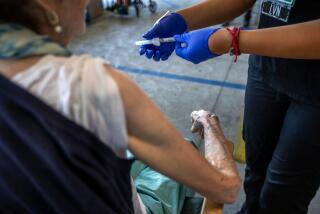CDC reports 19 more children died of swine flu last week
- Share via
Nineteen more U.S. children died from pandemic H1N1 influenza in the week ending Oct. 24, bringing the total to 65 since Aug. 30 and to 114 since the beginning of the pandemic in April, according to the newest data from the Centers for Disease Control and Prevention.
Two-thirds of those children had underlying medical conditions that put them at higher risk for complications, CDC Director Thomas R. Frieden said in a Friday news conference. In a normal flu season, 40 to 50 children die, so the swine flu is affecting children much more severely than seasonal flu.
Comparable numbers are not available for adults because there are no similar reporting requirements for them. As of Tuesday, 12,466 laboratory-confirmed hospitalizations for swine flu and 530 deaths had been reported to the CDC, but those are likely to be significant underestimates, Frieden said.
Estimates released this week suggested that perhaps 800 Americans had died from swine flu by the end of July. Frieden said the agency hoped to have real-time estimates for the entire pandemic period available in the next couple of weeks.
He said “many, many millions” of Americans now have been infected.
Supplies of vaccine for swine flu continue their slow growth. As of Friday morning, 26.1 million doses were available, an increase of 10.5 million since the previous Friday and 1.3 million more than were available Thursday. “There is not enough yet for all providers, but the gap between supply and demand is closing,” Frieden said.
About half of the doses given out so far have gone to children, and most of the rest to young adults, he said. About 1% to 2% have gone to the elderly, he said.
A White House spokesman said Friday that President Obama “has been and is frustrated” by delays in production and delivery of the swine flu vaccine. The CDC originally predicted that 40 million doses would be available by the end of October the actual amount was 26 million.
Two senators have asked Health and Human Services Secretary Kathleen Sebelius to explain the delays. CDC officials have said that the primary problem is that the virus originally used to produce the vaccine in eggs does not grow as quickly as the seasonal flu virus, impeding production of the vaccine.
An estimated 89 million doses of seasonal flu vaccine have been distributed, and the majority of them have already been administered. The agency expects more in November and December.
The CDC is still concerned about spot shortages of oral-suspension Tamiflu for young children. The liquid form of the antiviral is meant for infants and young children who have difficulty swallowing pills. Shortages began appearing in September.
The agency released 300,000 courses of the drug from its emergency stockpile on Oct. 1, and Frieden said it would release the remaining 234,000 doses in the stockpile over the next few days.
“We held back some portion before because it was not clear whether some parts of the country would need more than others,” he said. But the virus has become so widespread that it now makes sense to distribute it.
The agency has ordered more from the manufacturer, Roche Laboratories Inc., but does not know when that will be available because the company has been concentrating on making doses for adults.
Many chain pharmacies have begun compounding the suspensions, opening capsules meant for adults and adding them to liquids that are palatable to children. Parents should not do that at home, Frieden added, unless the physician prescribed pills for a child and the child cannot swallow them. Then it is OK to open them and add the contents to chocolate syrup or something similar.
Frieden said he has no particular concerns about whether trick-or-treating for Halloween could spread the virus. His advice: “Have fun, stay safe, and if your kids are sick, keep them home.”
--
More to Read
Sign up for Essential California
The most important California stories and recommendations in your inbox every morning.
You may occasionally receive promotional content from the Los Angeles Times.










